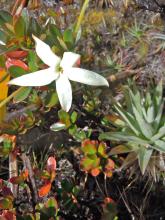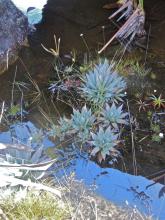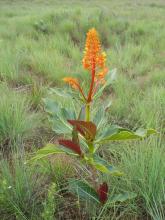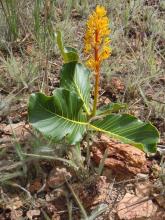The trip that took us to the unusual table mountains called tepuys lasted only 6 days and we spent only two nights and one full at at the plateau. However we had some days in the rainforest surrounding the tepuys too. In my view the chance of meeting a dinosaur is much greater there than on the rather naked mountain tops. I think Arthur Conyan Doyle was thinking of the hidden valleys at the foot of Auyantepuy and the others here in Canaima when he wrote his book.
Motor canoe on the river Churun into "the Lost World". We didn't see any dinosaurs but the highest waterfall in the world: Salto Angel.
To reach the Roraima tepuy we had to walk a bit crossing Gran Sabana, or rather a corner of it. Actually this part of the savanna should be covered by trees but due to regular fire started by the locals trees never get a chance. Only along the creeks and rivers some wood survive. Some ornamental plants could be seen along the path.
We set out from a small village and walked for two days. Day one: crossing the Gran Sabana. We slept in tents - 1st camping site.
The next day we reached the wooded scree at the foot of the mountain. Here we could see both Kukenan tepuy and Roraima. The right picture shows the vegetation-covered crack we climbed to the top.

Comments
Trond Hoy
Re: The Lost World found at last!
Wed, 07/27/2011 - 12:01pmAlthough grass and grass-look-alike plants dominated the vast undulating landscape many flowering plants could be seen.
Unfortunately I haven't found the names of any of these. Some are similar to popular pot plants.
The second one is Chamaecrista desvauxii. Quite a few were orchids, the red one is possibly an Epidendrum.
Unknown, but the second one is possibly Heliconia psittacorum or a close relative :
Trond Hoy
Re: The Lost World found at last!
Wed, 07/27/2011 - 12:37pmMore plants: Koellensteinia kellneriana (1 and 2)
Some species of the family Melastomataceae:
The orchid is Galeottia burkei
Trond Hoy
Re: The Lost World found at last!
Wed, 07/27/2011 - 12:59pm(To be continued)
Lori S. (not verified)
Re: The Lost World found at last!
Wed, 07/27/2011 - 8:53pmWow, what an adventure!! Stunning sights! The lowland (?) plants are incredibly exotic... there are probably only a couple for which I think I could guess the family (but I'd probably be wrong.) For example... is that odd spikey one some sort of horsetail (Equisetum)?
Waiting with great anticipation for the next installment... 8)
Fermi de Sousa
Re: The Lost World found at last!
Wed, 07/27/2011 - 9:45pmStunning pics, Hoy,
Looking forward to the next instalment!
cheers
fermi
Trond Hoy
Re: The Lost World found at last!
Wed, 07/27/2011 - 11:40pmThe undulating savanna goes up to about 1500m. I think the spikey one is a clubmoss although it doesn't fit the pictures I have found of clubmosses in South America.
Trond Hoy
Re: The Lost World found at last!
Thu, 07/28/2011 - 12:11amThe tepuys consist of horizontal layers of sandstone and although the rock looks blackish it decompose to pink sand. The tepuys are remnants of a huge plateau that once covered all the area.
Looking at the road ahead (it follows the green slanting vegetated line):
The campsite. About a dozen allowed campsites exist on Roraima. They have space for 2 - 12 tents and are always covered by overhanging rocky outcroppings creating a sort of cave. The floor is sand. You can spot them on a distance due to the more green vegetation at the mouth of the "caves". Lowland plants and grasses grow in the nitrogen-enriched soil by the campsites. Visitors unintentionally bring seed with their camping gear.
Some pictures of the rockscape. Here are all the rock that anyone could wish for in the garden:
No lack of drinkable water (without Giardia I hope). Caused by the daily rain and fog all depressions were filled with water and runoffs were everywhere.
Trond Hoy
Re: The Lost World found at last!
Thu, 07/28/2011 - 12:54amA lot of the plants on the plateau are endemic but it is hard to find names. I have not found a flora and names on internet isn't reliable.
Stegolepis guianensis is common:
The genus Utricularia (bladderworts) contains many strange plants. These red-flowered bird-pollinated species were rather common both as epiphytes and geophytes (Utricularia campbelliana and U. quelchii):
Pitcher plant (Heliamphora nutans), Celiantha imthurniana, probably a Paepalanthus sp and an unknown shrub:
Trond Hoy
Re: The Lost World found at last!
Thu, 07/28/2011 - 1:46amMore plants:
One of the showiest is Orectanthe spectrum. To the right: Seen from above.
Small shrubs and orchids dominated, here Bejaria imthurnii, Epidendrum ulei and Octomeria conelli.
Some unknown:
(To be continued)
Trond Hoy
Re: The Lost World found at last!
Thu, 07/28/2011 - 4:47amOne carnivorous bromeliad (Brocchinia hectioides) and some common orchids (Epindendrum dendrobioides, E. secundum and Octomeria sp)
The shrub Ledothamnus guyanensis and an unknown plant.
Another shrub, Maguireothamnus speciosus and rosettes of Orectanthe spectrum.



Howey (not verified)
Re: The Lost World found at last!
Thu, 07/28/2011 - 6:17amYour lovely photographs of the flora of this remote area make me feel like I am actually there in the Lost World - never knew such plants existed. Did you manage to collect any seeds? Love the one with the iridescent blue beetle plunked in the middle of those yellow flowers and red seed pods. Such a pleasure to see all this. Fran
Frances Howey
London, Ontario, Canada
Zone 5b
Trond Hoy
Re: The Lost World found at last!
Thu, 07/28/2011 - 12:55pmThanks Fran.
Sorry I found no ripe seeds!
Trond Hoy
Re: The Lost World found at last!
Thu, 07/28/2011 - 1:14pmStill more plants:
These huge tree ferns are possibly Blechnum schomburgkii but I am not sure! Celiantha imthurnia.
Unknown species. The tiny orchid had established itself under a stone in low light level and difficult to picture.
Monochaetum bonplandi. Symbolanthus elisabethae x 2. The Roraima sundew, Drosera roraima.
Trond Hoy
Re: The Lost World found at last!
Thu, 07/28/2011 - 1:50pmI noticed no naturally occurring grass but at the campsites some grass species had established. This is the nearest mountain meadow I found. Bromeliads (Brocchinia tataei #2) were rather common. The pitcher plant Heliamphora nutans was one of the showiest.
Paepalanthus convexus, Psychotria concinna x2
More unknown shrubs:
Trond Hoy
Re: The Lost World found at last!
Thu, 07/28/2011 - 2:33pmLast chapter!
This is the bathtubs! Often the water disappeared in sinkholes and reappeared in the foothills as creeks. The black rock erodes to pink sand.
Views from the edge. Gran Sabana. Kukenan tepuy. Fog is coming!
The wall. At the foot is Guyana. This gesneriad was growing in the moist air in the rainforest and underneath the Salto Sapito waterfall!
Toole (not verified)
Re: The Lost World found at last!
Thu, 07/28/2011 - 2:56pmWonderful journey Trond --- Thanks for posting.
Cheers Dave.
Lori S. (not verified)
Re: The Lost World found at last!
Thu, 07/28/2011 - 7:49pmAmazing scenes, Trond! Thank you for posting your photos!
Imagine a place where orchids are a dominant plant!
Were your guides knowledgeable about the plant species or did you have to figure out names from your photos?
Richard T. Rodich
Re: The Lost World found at last!
Thu, 07/28/2011 - 10:17pmEvery photo evokes at least one "What in the heck is that?!" from me. So interesting, every one!
Speaking of carnivorous plants, how were the bugs there? That white pitcher plant flower, gadzooks! And was it very windy?
Trond Hoy
Re: The Lost World found at last!
Sat, 07/30/2011 - 1:04pmFew bugs at the plateau, in fact I wondered what the carnivorous plants had for dinner. More along the rivers further down. Mosquitoes and a little blood sucking fly were all over your body in few minutes.
We did not experience strong winds at all. A lazy breeze was all.
You are welcome Lori - you have given me much pleasure with your Excursions ;)
The guides knew the common names of some of the plants. I have used Internet to figure out the names as best as I could. I have relied on others that have been there. Seems not to be any special flora to obtain.
Todd Boland
Re: The Lost World found at last!
Sun, 07/31/2011 - 4:54pmOMG! I'm so jelaous Trond...what a spot! I've seen TV shows on the tepuis but they have not shown the diversity of plants you have shown. I have always wanted to visit them...from both a plant AND a birding perspective.
Tim Ingram (not verified)
Re: The Lost World found at last!
Fri, 08/05/2011 - 10:44amTrond - what a privilege to see all your wonderful images of the Lost World. Plants just astonish wherever they are from! But all of these seem even more astonishing. Will you be writing up your trip anywhere?
Trond Hoy
Re: The Lost World found at last!
Fri, 08/05/2011 - 1:31pmYou shouldn't hesitate but take a trip! You will never regret.
We noticed several birds but I'm no birdman and didn't picture any.
You are welcome!
I have not been asked to write anything so I haven't considered it at all.
cohan (not verified)
Re: The Lost World found at last!
Wed, 01/25/2012 - 8:39pmI was looking forward to this thread for a long time, but kept forgetting to find it! Lots of great plants so far..
I saw a show about Roraima once, and they hiked across that same savannah, and I was wondering why it was treeless!
cohan (not verified)
Re: The Lost World found at last!
Wed, 01/25/2012 - 11:03pmI agree with Todd-- nothing I've seen ever showed much of the plants at the top- apart from some general views to show the odd shapes; glad to see that there are more colours and different species to be seen up close! Seriously cool place!
Gordon Tingley
Re: The Lost World found at last!
Mon, 02/25/2013 - 4:15amWhat an amazing adventure! I've always been fascinated by the Tepuis, and their strange and unusual plant life. Trond, I'm envious, but glad you shared the photos.
In your second post, there were two plants that I could identify to genus, but not any further. The last photo in that group is of a Heliconia (possibly psittacina given its short stature). In the line of photos above that, the last photo of a pink orchid is likely one of the hundreds of species of Epidendrum (perhaps imantophyllum?- see http://www.orchidspecies.com/epiimatophyllum.htm )
I'd love to identify the plant in the top row, second photo, (terminal panicle of orange buds, yellow flowers, glossy leaves with prominent veins). Thanks so much for sharing the photos!
Trond Hoy
Re: The Lost World found at last!
Mon, 02/25/2013 - 9:54amThanks Gordon, and you are welcome!
Regarding the plant names I agree, it is a Heliconia, and possibly psittacorum (!) I think.
The orchid is also a Epidendrum but I'm not sure of imanthophyllum/flexuosum. However there were several very similar but not identical species in the woodland along the foot of the tepuy. They were very slender but several meters tall.
You should take a trip - it is an Eldorado for orchidophiles!
Gordon Tingley
Re: The Lost World found at last!
Tue, 02/26/2013 - 6:19pmOne of these days, we'll make it to South America. Toss up about where to go... there are so many temptations, tropical, temperate and alpine! The second photo of your second post looks very much like a Medinilla, but that genus is old world.Do you think it is also from the Melastomaceae? The plant beside Koellenstenia kellneriana is a Cleistes, possibly rosea, though there are at least nine species of Cleistes native to Venezuela. I'm still trying to identify that second plant in your second post!
Trond Hoy
Re: The Lost World found at last!
Wed, 02/27/2013 - 12:10amGordon, I have found one name for it but I'm not sure it is the right one: Curatella americana. Some hits when I google look right but not all.


I agree to the pink orchid looks like a Cleistes rosea.
That's why I chose Venezuela! We got it all - rainforests, rivers, mountains, beaches - all we wanted ;D